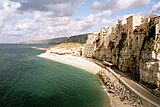Tropea
| Tropea | ||
|---|---|---|

|
|
|
| Country | Italy | |
| region | Calabria | |
| province | Vibo Valentia (VV) | |
| Coordinates | 38 ° 41 ′ N , 15 ° 54 ′ E | |
| height | 60 m slm | |
| surface | 3.2 km² | |
| Residents | 6,221 (Dec. 31, 2019) | |
| Population density | 1,944 inhabitants / km² | |
| Post Code | 89861 | |
| prefix | 0963 | |
| ISTAT number | 102044 | |
| Popular name | Tropeani, Trupiani (dialect) | |
| Patron saint | S. Madonna di Romania | |
| Website | Tropea | |
Tropea is an Italian commune in the Calabria region in the province of Vibo Valentia with 6221 inhabitants (as of December 31, 2019), on the coast of the Tyrrhenian Sea .
geography
The place is located on a rock about forty meters high on the Tyrrhenian Sea . From the old town you have a good view of the fine sandy beach, partly with rocks, and the sea. When the weather is clear, the view extends to the volcanic island of Stromboli and the other Aeolian islands . Not far from the center is the pilgrimage church of Santa Maria dell'Isola, located on a rock .
South of Tropea is the famous Capo Vaticano viewpoint .
history
Tropea was mentioned for the first time in the 1st century AD by Pliny the Elder . According to legend, the original name is "Hercules Harbor", as Hercules is said to have settled here to relax after his adventures.
Tropea has been the seat of a diocese since the 7th century. In 1094 a Latin clergyman was the first to succeed the Greek bishops, but the population still belonged to the Greek language group in large numbers in the 14th century.
Around 1000 AD Tropea developed into a prosperous town and was inhabited by numerous noble families in the course of feudalism , favored by tax and administrative freedom.
In the 13th century, Tropea was rebuilt in its current state to protect it against the Saracen invasions , enthroned on a rock above the sea. Over the centuries, regular earthquakes caused severe damage to the city, so after each quake the residents rebuilt the city on top of the ruins, as evidenced by archaeological excavations from the 19th century.
In the 19th century, Tropea was a rich commercial center and retained its independence as a city-state until 1806 . However, the arrival of the French marked the long collapse of the city that followed, which could only be reversed with the beginning of tourism.
tourism
Due to its location and the well-preserved old town, Tropea is one of the most popular holiday destinations in Calabria. The area offers many small bays and white sandy beaches. A variety of leisure and entertainment options have also been created to attract tourists.
Attractions
- The Norman Cathedral of Tropea
Personalities
- Albert Anastasia (1902–1957), Italian-American mafioso , was born in Tropea.
- Pasquale Galluppi (1770–1846), Italian philosopher , was born in Tropea.
- Vincenzo Lauro (1523–1592), cardinal and diplomat, was born in Tropea.
- Francesco Massara (* 1965), Roman Catholic Archbishop of Camerino-San Severino Marche, born in Tropea.
- Gerhard Rohlfs (1892–1986), German Romance studies and university professor , was an honorary citizen of Tropea.
Culinary specialties
Tropea is known for its red onions ( cipolle rosse , also cipolle di Tropea ), which taste particularly sweet.
Town twinning
-
 Zvenigorod , Russia, since 2012
Zvenigorod , Russia, since 2012
Web links
- Website of the city of Tropea (Italian)
Individual evidence
- ↑ Statistiche demografiche ISTAT. Monthly population statistics of the Istituto Nazionale di Statistica , as of December 31 of 2019.
- ↑ Santo Lucà, Un copista e proto papa di Tropea nel secolo XIV . In: Bollettino della Badia Greca di Grottaferrata 53 (1999) web version
- ↑ Press release ( Memento of the original from August 19, 2016 in the Internet Archive ) Info: The archive link was inserted automatically and has not yet been checked. Please check the original and archive link according to the instructions and then remove this notice. of the Calabria region , accessed August 19, 2016.





